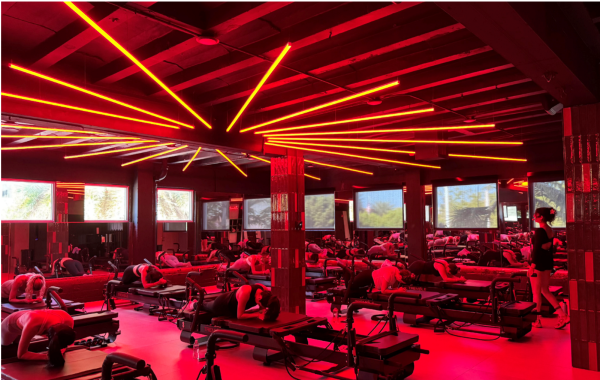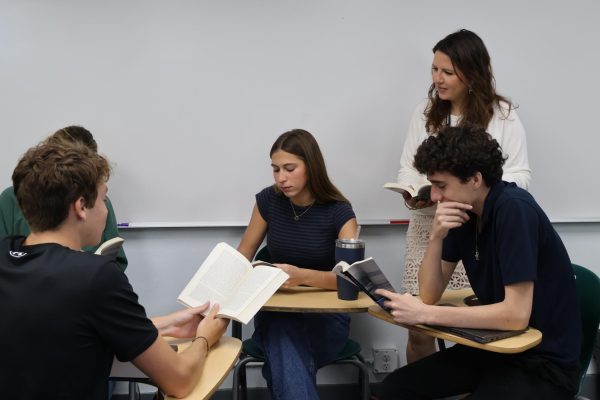Gender dynamics at RE
Recent enrollment trends defy traditional gender norms, but questions about true parity remain
Yuhan Liu ’21, Luisa Guarco ’19, Charlotte Wang ’21, Joan Joseph ’21, and Joshua Buttrick ’22 work on their robot in between matches during the fall RE VEX tournament.
In an effort to combat the gender inequalities that plague many industries, especially in STEM fields, schools across the United States have increasingly begun to question the gender dynamics that happen in the classroom. At Ransom Everglades, some of the traditional associations — men focus on STEM; women focus on the humanities — are eroding. But true gender parity remains an elusive goal.
According to recent statistics shared by Associate Head of School Dr. John King, progress toward gender parity seems to be underway. Over the past three years the gender gap has decreased in AP Economics, Computer Science, AP Calculus 2, Linear Algebra, and Architecture; in AP Calculus 1, the gap has been closed entirely.
Students themselves seemed to register this change, noting that STEM classes seem more gender-balanced. “There are a ton of girls involved in STEM,” said Marley Rywell ’19. “I don’t think that’s representative of the country, but at Ransom Everglades, that’s something that’s clear.”
And yet, despite these improvements, there is still a substantial gender gap in higher-level STEM classes. Linear Algebra, one of RE’s most advanced math classes, has three girls in a class of 10. AP Calculus 2 faces the same problem: “Four out of 17 of the students in my Calc 2 class are girls,” explained Isabella Peña ’19.
AP Physics C is an interesting anomaly — this year, the class is almost evenly split, with five girls and seven boys. This gender parity is unusual; in the two previous years of AP Physics C, there was only one female student per class.
“In general, regular Physics and AP Physics 1 are more balanced, but there are fewer female students who end up being able to sign up for AP Physics 2 and C, which is the second tier of physics,” said physics teacher Mr. Paul Natland ’02.
Some extracurriculars face gender imbalance issues, too. This year, the incoming Speech and Debate class was primarily female, but there remains a striking difference in the number of girls and boys who choose debate versus speech events.
Speech and Debate Coach Ms. Kate Hamm has seen boys in her classes assume that debate events are their only option; she says it is a “societal thing.” Girls, meanwhile, tend to prefer speech events. In Public Forum — a style of debate with two-person teams — there are eight female students and 18 male students.
When asked why girls might be discouraged from signing up, Debate Team Co-Captain Oliver Stern ’19 said, “The only national tournament where I saw a fully female team in the final round of a tournament was 2015, so I think that plays into the idea that if they don’t see representation, why would they do it?”
Ms. Karen Key, sponsor of the Math Team, echoed Stern’s suggestion that representation breeds participation, emphasizing the importance of role models on the team.
“The current leadership is 50/50,” she said. “When I first started running the team, it was a strong male leadership. In the class of 2017, there were girls who joined and stuck to it, and they encouraged other girls to join.”
Ms. Key explained that the spirit of the Math Team centers more on knowledge than on gender — and the team’s treasurer, Donna Zheng ’19, agreed.
“Based on personal experiences, I feel that girls on the Math Team do get treated equally, especially in recent years where we see an increasing participation of girls in vital roles,” Zheng said.
The Math Team’s gender balance varies, but this year it is roughly equal, and three of the team’s four officers are girls. Not every grade has an equal gender balance on the team; many strong female competitors are upperclassmen, but their younger peers feel more isolated.
Surprisingly, the bigger gender gap at Ransom Everglades seems to be in the humanities. The Bowden Fellowship is a grant opportunity for rising RE seniors who want to pursue passion projects in the humanities. When the fellowship was created in 2016, two of the six Bowden fellows were boys. This year, there were 12 female fellows — and not a single male student.
This link between girls and the humanities persists in some courses. According to Dr. King’s research, French classes and AP Psychology have maintained a steady outnumbering of male students by female students over the past three years. This year, there are two sections of AP English, with a combined total of four boys in the two sections.
The number of male AP English students varies by year, however, and Dr. King emphasized that it is difficult to identify definitive trends, since RE classes are so small. In addition, statistics can be significantly altered by the preferences of individual students.
In English classes with a more balanced gender split, however, other issues arise.
Ms. Danielle Ellis explained that in the majority of her classes, “the gentlemen do most of the talking.”
Girls who do participate in discussions often have to handle interruptions and other issues. “I have girls who have made it a point to make their voices heard,” Ms. Ellis said, “but girls get cut off far more frequently than boys do. Female students tend to get argued against more. I’ve seen some really wonderful theories railroaded.”
Class discussions often become “battles of the sexes,” Ms. Ellis said, reinforced by physical separation — girls and boys occupying opposite sides of the classroom.
In both classes and extracurriculars, this pattern of boys overlooking girls’ voices may lead to perceptions of a greater gender divide than actually exists.
“I think at Ransom there are more girls interested in STEM,” Stern said, “but more guys show their active presence in it which is why people think there are fewer girls involved.”
Holly Steinberg ’19 agreed that this is a problem. “It is sometimes harder for girls to get their voices heard on campus — which, sadly, leads to lost opportunities,” she said.
While larger social movements may ultimately do more to affect the STEM and humanities gender balance than anything else, RE students agreed that questioning stereotypes and amplifying quieter voices on campus could help both girls and boys feel more comfortable pursuing new subjects.
“I don’t necessarily think it’s a bad thing that one gender likes something more than another,” said Nicole Verde ’19, “but I think that everyone should be encouraged to do whatever they want.”
“Nothing can be fixed if the issue is never actually addressed out in the open,” said Ms. Hamm.







